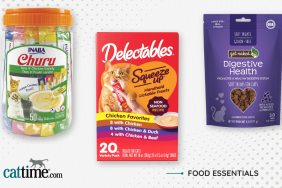The New Year is just around the corner, and with the New Year comes — what else? — New Year’s Resolutions. One of the most common resolutions is to lose weight and get healthier. But, it’s not just us humans who could benefit from a resolution like this.
Our cats, especially if they’re indoor cats, are often a little thicker around the middle than they should be. So, why not include your feline friend in your New Year’s Resolution, and help them get slim and trim too?
It will help them feel better, could reduce the occurrence and/or severity of many illnesses, such as fatty liver, diabetes, arthritis, and more. It could also help them live longer while improving their overall quality of life.
Here’s some advice for safely and simply helping your cat slim down.
Make Sure Your Cat Actually Needs To Lose Weight

To decide whether your cat needs to lose a little weight, check their ribs and backbone. If you can’t feel them easily, your cat can probably stand to shed some ounces.
Also, check to make sure they don’t have a big lower belly — that’s a prime place for many overweight cats to store excess fat.
If your cat needs to lose some weight, don’t despair! Even indoor cats can win the battle of the bulge.
Read on for some tips you can implement easily to help them slim down and reveal the sleeker figure hiding beneath the chub.
If your cat needs to lose some weight, don’t despair! Even indoor cats can win the battle of the bulge. Read on for some tips you can implement easily to help them slim down and reveal the sleeker figure hiding beneath the chub.
1. Switch Their Food
Consider switching your cat from highly processed commercial foods, such as kibble or canned food, to a species-appropriate raw food diet.
You may need to make the change gradually. For example, if you feed your cat kibble, you may want to switch to a canned wet food first, and then on to a raw diet.
There are lots of resources available to help you learn how to switch your cat to a raw diet. The website catcentric.org has lots of great information.
2. No More Free-Feeding
If you currently free-feed your cat, consider cutting off that all-you-can-eat buffet and feeding them two or three times per day instead.
While cats should eat more than once per day, leaving food down all the time can often lead to unnecessary weight gain.
Remember, though, that cats need to eat daily, so don’t be tempted to cut off food for a few days. Fasting cats is not recommended, as it can have severe consequences, such as fatty liver syndrome, also known as hepatic lipidosis, which can be fatal.
3. Stick To An Exercise Routine
Cats are creatures of routine, so use that to your advantage, and get your cat in the routine of exercise. Spending ten minutes in the morning and ten minutes in the afternoon playing with your cat can do wonders for their health and their waistline!
If your cat is out of the habit of moving around, it may take some time to entice them to play for 20 minutes per day, but be persistent. Eventually, they’ll get into the spirit of things!
4. Add Some Variety
Variety is the spice of life, and exercise is no exception. Try lots of different toys to entice your cat to play — some of my cat’s particular favorites are “Da Bird” and feathery wand toys. He’s almost 17 now, but when he was younger, he also loved chasing toy mice.
Lasers are a great option for lots of cats too. If you go the laser route, give them a “real” toy at the end that they can actually “catch,” so they don’t get frustrated. Also, don’t ever shine the laser into their eyes.
Rotate through toys and get creative about the toys you try for maximum effect. Crinkly paper has always been a hit with my cats.
5. Enjoy The Great Outdoors Safely
Get outside and get some fresh air. With some time and practice, you can get your cat used to a harness and leash and take them on walks with you. I introduced my cat, Gryphon, to a harness and leash a few years ago, and he loves going out on walks.
Just remember to take it slowly — put the harness on them first when they’re in a safe, familiar place. When they’re used to the harness, you can attach the leash. Let them get used to the leash when you’re in safe place before taking them into an unfamiliar environment.
It can take a few weeks to get your cat used to the harness and leash, but there’s no rush. Better to make it a pleasant experience, even if it takes a little longer, than an unpleasant one.
With cats, it’s also a good idea to let them set the pace and the direction of the walk. Don’t drag them around, but instead, encourage them to walk with you. And remember they love routine, so try taking the same route every time you walk with them.
Before you know it, they may be walking with you better than a dog would!
6. Try Some Agility
Agility for cats? Yep, that’s right: agility courses can be a great way to help your cat get some fun exercise!
You can go online and see examples of agility courses you can set up for your cat right in your own home. Use your cat’s favorite toy to lure them over and through the different obstacles.
It may take a little time to get your cat used to doing agility, but the physical and mental stimulation it can provide can be hugely beneficial for her overall wellbeing.
With cats, it’s best to approach weight loss slowly. Remember, slow and steady wins the race. Losing weight too rapidly can cause inflammation, particularly in their lungs and/or joints, and it can also cause hypoglycemia.
Implement the suggestions above in a moderate and mindful way to safely and easily get your cat on the road to good health.
Do you take steps to keep your cat in good shape? What’s your advice for other cat parents? Let us know in the comments below!
-By Kristin Clark, MA, CSAN
Editor-in-Chief, Raw Pet Digest
Founder, Raw Pets Thrive Movement









